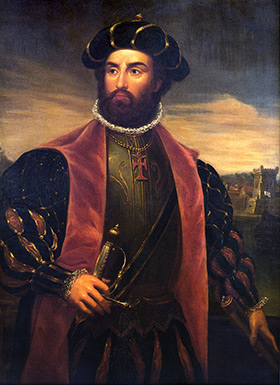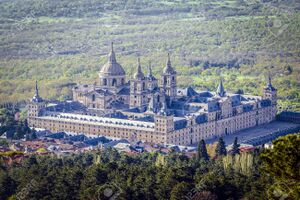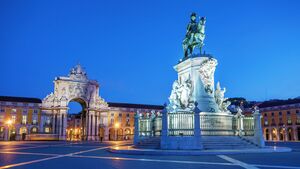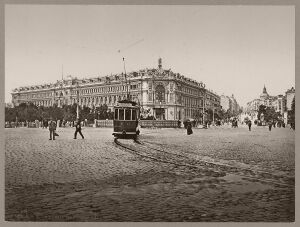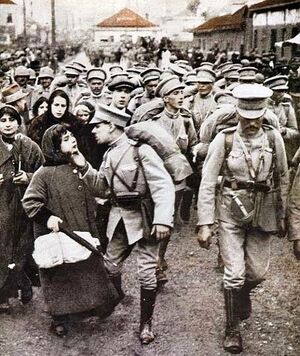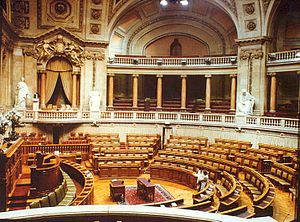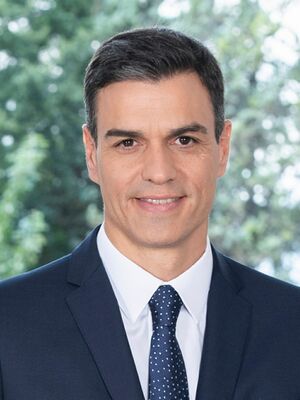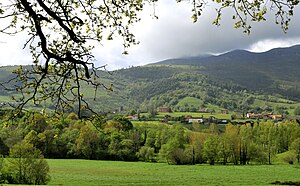Produzland
This article is incomplete because it is pending further input from participants, or it is a work-in-progress by one author. Please comment on this article's talk page to share your input, comments and questions. Note: To contribute to this article, you may need to seek help from the author(s) of this page. |
Kingdom of Produzland [a] O Reino de Proádusia | |
|---|---|
Motto: "Nos Sustinere." | |
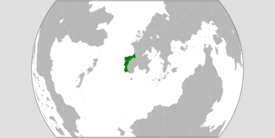 Official map of the Kingdom of Produzland | |
| Capital | Burlon |
| Largest city | Burlon |
| Official languages | Produese |
| Recognised regional languages | Produese, Cabecan, Aenian, Cadasan |
| Ethnic groups (2015) | Produes 89.70% Cabecans 3.612% Others 6.79% |
| Demonym(s) | Produes, Produese |
| Government | Parliamentary Constitutional Monarchy |
| Riccardo Bonadeo, PdP | |
| Legislature | Tribunais Gerais |
| Senate | |
| Congress of Deputies | |
| Kingdom | |
• West and East Aenicia Split | May 29th, 887 |
• Cavale and Galicia Split | March 4th, 987 |
• Establishment of the Kingdom of Cavale and Galicia | February 19th, 1140 |
• De Facto Establishment of the 2nd Kingdom of Produzland | June 20th, 1308 |
• De Jure Establishment of the 2nd Kingdom of Produzland | January 15th, 1715 |
• Established of the Federal Republic of Produzland | July 16th, 1935 |
• Establishment of the 4th Kingdom of Produzland | February 18th, 1980 |
| Population | |
• 2019 estimate | 61,432,763 (20) |
• 2019 census | 61,432,763 |
| GDP (nominal) | estimate |
• Total | 627,875,000,000 |
• Per capita | 10,220 |
| Gini (2011) | 34.67 medium |
| HDI (2011) | 0.781 high |
| Currency | Rozar (ROZ) |
| Date format | mmddyyyy |
| Driving side | right |
| Calling code | +55 |
| Internet TLD | .prd |
Produzland, officially, the Kingdom of Produzland (Produese: O Reino de Proádusia), is a sovereign state in Greater Olympus. Produzland is located on the western half of the Orthurian Peninsula in Southwest Lira. Produzland borders the Aurum Ocean in the west, and Meronnia in the North-East, as well as Parthonopia in the east. The Kingdom covers an area of XXXX square kilometers with an oceanic and mediterranean climate. It is a parliamentary constitutional monarchy with 38 million inhabitants (2014) and King Joseph III as king since 2019.
Around 455 a group of people known as Aenians invaded the Orthurian Peninsula, the Aenians were called the "Produese" as they mixed with the local Orthurians of the the Orthurian province of Produsia. After the fall of the Orthurian Empire, the most notable nations to arise were Aenícia and Calmatia. West Aenícia split from Aenícia to become Cavale a few centuries later. After the division of Calmatia over the course of the middle ages Cavale conquered most of Western Orthuria and became the successor state to Produsia. After a history of imperialism and many royal dynasties, the empire fell apart over the course of the late 1800s and early 1900s. This resulted in a dictator seizing control of Produzland in 1935. The dictatorship was removed in 1980 with the monarchy being restored and Produzland in the modern day being a leading nation in Liran politics.
Produzland is ones of the leading countries in seafood production and luxury items with companies like Calmatia and Ludovico, Venâncio, Gárcere, Rego-Dalgarno Hotel Company, and Vítor Loureiro. Manufacturing is the dominant force in the country with significant contributions from refining. The parts made in Produzland are both exported and made into finished products, though the economic goal of the nation is to export the majority of parts out of the country, while keeping/importing some parts for local manufacturing before exportation. Imports include raw materials as well as finished goods and services from other countries. The resources on hand and the priorities of Produzland influence what type of refinement and manufacturing will take place. Produzland's manufacturing specialties include trains, automobiles, luxury goods, and electrical equipment.
Etymology
The Orthurian Empire named their westernmost province Produsia, meaning "Land of Carrots", which would evolve into Produzland in Lorian. The state that is now Produzland was originally called The Kingdom of Cavale & Galicia until the de facto Kingdom of Produzland began with King Henry I being placed on the Cavallian and Aenician throne. This became de jure in 1715 with the West Bresbon Decrees.
The standard way to refer to a citizen of Produzland is as a "Produe."
History
Early History (-490)
There is little written record of the first civilizations in modern Produzland, however archaeological evidence marks the oldest traces of human life in the region around 1.3 million years ago, living hunter-gatherer lifestyles, and making use of the main rivers of the country in the As Vega and Galicia. The region was the agricultural heartland of Orthuria until the region was brought under the rule of the Orthurian Empire. They named the province Produsia, after the abundance of carrots in the region. Produsia became an integral part of the empire until the Aenian people of northern origin were migrating throughout northwest Orthuria, they set up multiple kingdoms in the north under Aenian control. northern Produsia still had a very large Orthurian population at the time, and the breeding between the two people groups would eventually form the majority population of the region until the modern day.
Orthurian Produsia and Early Middle Ages (490-1140)
Under the rule of the Orthurians two main people groups rose to prominence in the west, the Aenians and Calmatians. With the fall of the Orthurian Empire over the course of the 5th century, the two people groups had set up their respective domains. Similar to the Aenians, the Calmatians were a fractured and spread people group, at some points Calmatian kingdoms would comprise territory even north of the Mazarico River, where they took the great city of Olivrium from the Orthurians. During the 6th, 7th, and 8th centuries the Aenians had unified under one country, the Kingdom of Aenicia, while the Calmatians remained fractured, but began to form proper nationstates including the Kingdom of the Rodaves, the Kingdom of Selcear, and the Kingdom of Cadascun, later known as Portuária, however at the time the three kingdoms all spoke a common language, Calmatian, the predecessor to modern Rodavese as the language was pushed South by the early Produese.
Due to a succession crisis in Aenicia in 879, the country was divided into West Aenicia and East Aenicia, the former being ruled by the bastard son of King Alfonso II of Aenicia, Ferdinand and the Galician House of Fonseca, and the latter ruled by Alfonso's legitimate son Vicente and the already Aenician ruling House of Outeiro. West Aenicia and East Aenicia both held large chunks of territory from Aenian expansion southward since the beginning of the middle ages, East Aenicia held the old united capital of Relâmpago, while West Aenicia originally made Arencia the capital of the new country.
The crown of West Aenicia split in 997 after the death of Ramiro II of West Aenicia, he split the country into north and south, the north known as the Kingdom of Galicia, a historical name for the region, ruled by his brother Alfonso III, the south took the name "O Reino de Cavela", or the Kingdom of Cavale ruled by Ramiro II's cousin Ferdinand III.
Late Middle Ages (1140-1486)
The crowns of Cavale and Galicia unified again under King Peter I of Cavale and Galicia. This nation state would become the leader of Produese unification and the predecessor state of Produzland. During this period the country is often referred to as simply Cavale. This became an era for advancement for the region, Cavale was cemented as the dominant Produese state. However it yet to expand southward, Vincent II set his eyes on the historic Orthurian city of Luville, which had been in Cadasan hands for centuries. King Vincent personally led an army to the walls of Luville. Luville had always been poorly held by the Cadasans for the last few centuries as their northernmost territory, however Cavallian monarchs had never seized the opportunity. Vincent II led an army directly to Luville while another fought their way to the banks of the Mazarico to cut off Cadasan reinforcements from the city. The city was captured and prestige grew for the united kingdom.
In 1267, tensions were high and lingering from the recent Battle of Luville between the neighboring countries of the Kingdom of Cavale and Galicia and the Kingdom of Cadascun that recently took over the County of Cojazeira from the Rodavese, which would eventually finally be set off when Cadasan king Alfonso VI died in battle against the Selcenese in the Battle of Mergulhe-O-Grande. Cadascun replaced the king with 3 month old Prince Henrique of Calmatia, which gave Cavale the perfect chance to take over Anavede and all the south bay area, currently under Cadasan rule, and perhaps even all of the Kingdom of Cadascun. So in the summer of 1267, the Cavallian forces crossed the Mazarico River into Cadascun. Already dealing with internal issues, Cadascun was easily defeated and swept aside at Anavede, Gretia Novo, and Azevedo, until King Vicente II himself and his army arrived at the walls of Cadascun capital, Portuaria. Realizing the city and it's people could be eliminated, the Cadasans surrendered. Cavale firmly incorporated Cadascun into it's territory, which would soon bring it into conflict with the Rodavese and the Selcenese.
In the 13th century the Kingdom of Velarre and the Aenician Duchy of Sundrescia had been in fierce competition over Cabeca. Velarre forming out of the Kingdom of Lurrak in the 1100s. While Sundrescian was Aenian as opposed to Cabecan like Velarre, they still vied for power in the region ever capturing the city of Lurrak itself, renaming it to San Aurelio after the Saint Aurelius.
Due to Gabriel V of Aenicia being incapable of ruling, the Cavallians took the opportunity to press their claim to eastern Galicia, which spiralled into the War of the Thymes in 1301, the war soon turned into a war of succession when the Cavallian king was killed in battle, which with the help of Philip III the Vain and the Sundrescians put Henry I, Count of Lugo on the throne of Aenicia and Cavale in 1308, leaving the two as independent kingdoms under one monarch. At this point they were practically united however. This began the de facto Kingdom of Produzland. The realm had several problems that would plague it for the coming decades, however after time the people of the country would come together and a string of competent monarchs would come to create one of the most powerful nations and empires in history.
Early Produese Empire (1486-1550)
In 1486 Ferdinand VIII took the Produese throne from his father, which historians claim as the beginning of the Produese Golden Age, the Parthonopian Renaissance was prevalent in the country with artists like Osório Da Rosario, Luca Melo, and Balduíno Hernandes. Ferdinand VIII is regarded as the founder of the Produese Empire, over the course of the 16th and 17th centuries, the Produese Empire expanded it's influence heavily in Nori and it's southeastern islands. The first example in 1513 Aloisian explorer Aleixandre do Orestes became the first Liran to land on mainland Nori, despite failing to colonize mainland Nori, this opened up the gateway for Produzland to become the dominant Liran power in east Nori. Twenty years later in 1533 Aleixandre do Orestes and company landed on the Strait of Marque island of Comona, establishing São Diego. Years later another company landed on the mainland and established the colonies of Novo Aenicia and Senãles Alto e Baixo in modern Carelia. The trade of the empire made the monarchy immensely wealthy and the gold of the southeast flowed back to Burlon.
The ruling Lugo dynasty also had ambition on the continent, allying with the neighboring nations of Parthonopia, Meronnia, and Velarre to halt Lunderfrausian advances southward, Produzland supplied troops to the famous Siege of Lepanto, a victory for the southern powers. During the war, Ferdinand VIII seized several islands north of the Lunderfrausian coast, using Ferdinand's claim to the islands through his wife as a casus belli. King Ferdinand also continued Produzland's policy of expanding southward deeper into the As Vega and Calmatian territory, the southern As Vega became a favorite location for Ferdinand VIII, converting the Selcenese Ciduarte Palace in Granarón into renaissance style, and it became one of Ferdinand VIIIs top homes of his court over the course of his reign.
When Ferdinand VIII passed in 1521, he left Produzland in the best position in Lira, however tragedy struck when his son King Henry III, was murdered in a jousting accident in 1539, this lead way however to second son Joseph the Colonizer to revamp the Produese Empire in east Nori with the Produese Gulf Company to promote Produzland to the richest nation in Lira, and the House of Lugo one of the richest in the world.
Joseph's first major feat in his reign being in 1543 when Jorge Adão da Coutinho landed in southern Kiteahu and established Fort Santa Ângela on an island he called Cavaco. Da Coutinho also landed in the eastern islands of modern Jashnagar a few years later, which he and his fleet gave it the name 'Jaixnágar'.
In 1546 the wealthy Republic of the Rodaves began to collapse with wars with Parthonopia and King Joseph took the opportunity to seize the republic. Produzland already held the County of Cojazeira, having been in personal union for a few decades which had sparked tension with the Rodaves, but the Rodaves couldn't afford to go to war with Produzland with their colonial bids draining the republic's treasury. King Joseph personally lead a sacking of the city of Cartaganca. After the fall of the Rodavese capital, the Rodavese forces across the country began to collapse and the Rodaves was annexed. Rebellion and sparse guerilla fighting in the former republic would continue until the Rodavese Revolution of 1643.
Vincennine Produzland (1550-1700)
Tensions with Meronnia were present over the last few decades, mainly as colonial rivals in south-east Nori and Cabeca, which recently was a source for tension as the Kingdom of Velarre became a vassal of Meronnia. The Lugos decided to set up several agreements with their northern neighbor including several arranged marriages and giving Produzland influence in Nori and Meronnia in Meridiq in the Treaty of Relâmpago. After Joseph I passed in 1550, he was replaced with his son Philip, and through his mother Philip also inherited the Kingdom of Meronnia in 1551 leaving him as King Philip I & IV of Produzland and Meronnia and he one of the most powerful men in history as Produzland continued their colonial reign in east Nori.
In 1582 when King Philip died, he split his empire in two with his son Vincent III inheriting Produzland and his daughter Ermelina I inheriting Meronnia and beginning the Meronnian branch of the House of Lugo. The two nations stayed very close allies throughout history though.
In 1612, rivalries with northern Lira and disputes between Lunderfrau and the Lugos over islands in the XXXX Sea, especially Lunderfrausian protests to the Produese inquisition in the territory spiraled into the 20 Years War, in which Produzland and Lugo prestige suffered a catastrophic defeat, and the Lugos lost their monopoly on Norian trade. The war became worse for Produzland when the Rodavese Revolution sprung up, revolts began to spring up in the Rodaves and in Produese owned Cabeca, causing King Vincent IV to effectively lose control of the former. Unlike the previous independent Rodavese state, the Rodaves became a kingdom and crowned Louis of the House of Beltrán as King Louis I of the Kingdom of the Rodaves. At the same time Meronnia became involved in their own religious war in which Produzland was heavily involved in to continue Verroist rule in the nation. This became another defeat for the Lugos as they were deposed in Meronnia in 1684.
Beltránian Produzland (1700-1818)
In early 1700 Charles I died childless, following the rules of Produese succession the crown passed to King Louis III of the Rodaves of the House of Beltrán. Louis III would pass however before he could be crowned, leaving the thrones of Produzland and the Rodaves in the hands of his five year old son Prince Vícenç de Beltrán i Portell. Vícenç became Vincent V of Produzland and Vincent II of the Rodaves. However the Kingdom of Parthonopia, a staunch ally of the Rodaves rejected the idea of a personal union between Produzland and the Rodaves, so Parthonopia declared war in 1701. The young king's regent was his uncle Carles, Duke of Sevidiz who responded quickly to the Parthonopian war. However after a couple of major naval defeats in the Rosel Sea Produzland and the Rodaves surrendered in 1709. In the Treaty of XXXX, Produzland gave up the island of Aloisio to become a kingdom in a union with Parthonopia. It also ceded parts of the eastern Rodaves and several other border regions. The border established in the treaty is the one that remains till today between the two countries.
Vincent was formally crowned in Araújo by the Archbishop of Araújo earlier that year at the age of 15. One of his earliest acts was the dissolution of the current feudal system in Produzland, removal of any regional power with the Crown of Aenícia, and formal integration of the Kingdom of the Rodaves into the larger kingdom, all included in the West Bresbon Decrees of 1715. This also de jure established the centralized Kingdom of Produzland.
In 1734, at the age of 39 Vincent V began expanding the borders of Produzland into the regions he saw fit. With an alliance with Meronnia, Produzland and Meronnia invaded the financially struggling Kingdom of Velarre and deposed Louis II, who 50 years before had escaped vassalage of Meronnia in the Meronnian religious wars. Produzland drove quickly through the Cabecan lands and annexed most of the modern state of Cabeca into the kingdom. Vincent established the new Principality of Cabeca with the lands taken from Velarre and many lands from the Duchy of Sundrescia with Cabecan populations. He then declared the heir to the throne of Produzland would be given the title "Prince of Cabeca".
Continuing the expansion policy Produzland invaded the Kingdom of Aloisio in 1738, kicking off a second war with Parthonopia. However Parthonopia was unprepared and fought sloppily, leading to a massive destruction of the joint Aloisian-Parthonopian army on the island, and the destruction of the Parthonopian fleet in the Rosel. Vincent V declared his second son Philip King of Aloisio as Philip I at the age of 18, as Philip was not directly in line for the throne. After the end of the war with Aloisio and Parthonopia, King Vincent turned his eye north towards Meronnia, who over the last decade had sprung into revolution and deposed their ruling dynasty. King Vincent was determined to restore the monarchy of the country and invaded with the help of Meronnian royalists that fled to Produzland. The Produese sacked the city of Senone in 1739 and restored the monarchy of the country, a resounding victory and restored much of the lost prestige of the 17th century for Produzland.
In 1751 the king of Produzland and son of Vincent V, Vincent VI died childless. This lead to King Philip I of Aloisio being crowned King Philip II of Produzland as well. He fully integrated Aloisio into Produzland the next year. The beginning of the end of the Produese colonial empire truly began a few years later when in the Strait Wars with Velkanika, the colonies of New Aenicia and Senales were awarded to Meronnia.
The reign of Philip II became an era of reform for the Produese kingdom after a rough start to the young monarch's reign. Produzland had been an absolute monarchy for all of its history, excluding the Rodavese Republic, and with the emergence of the enlightenment calls for reform grew in the country. Philip was a moderate when it came to democracy, and was open to the idea of it, he was by no means a Republican and believed in the power of his monarchy, so he implemented a system of a Parliament and an appointed Prime Minister that would govern under the supervision of the monarchy. He had a constitution drafted by appointed bureaucrats in 1771, and had a Prime Minister selected as head of government. For a country that had no previous history of democracy, Produzland had a period of stability under their popular monarch and parliament.
Prince Carlos, the grandson of Philip II inherited the throne after his grandfather's death in 1801, becoming Charles II. At the end of the Meronnian Revolution near the same time, the directory of the Meronnian republic offered Produzland territory and a sphere of influence over Parthonopia if they had joined the ongoing war between Meronnia and the Parthonopian states. Despite personally not favouring the republic and Augustin Calvet, due to pressure from the parliament, Charles II had Produzland side with them in the Great Continental War.
Produzland and Meronnia turned victorious in the war against the coalition and several western Parthonopian territories were annexed into Produzland as well as the former Principality of Trevisa merged with lands from the Principality of Terracina into the Kingdom of Trevisa-Terracina.This alliance was turned on its head in 1813 however when Augustin invaded Produzland and deposed King Charles, as well as forcing his son to give up his right to the throne. Calvet installed his brother Francis on the Produese throne and forced Produzland to give up many of the territories won in the war against the coalition and Cabeca, being turned into sister republics of Meronnia. The Produese people engaged in fierce guerilla warfare against their Meronnian occupiers, and when Augustin was assassinated and the war turned against Meronnia, King Francis was deposed and replaced with Charles II's heir, and Produzland regained many of its lost territories, including a great sphere of influence over Parthonopia.
Late Produese Empire (1818-1925)
Despite ending up victorious in the Great Continental War and Carlos III with a firm grip over his realm again, the country was in ruins from the decade of war and both the king and the reinstated Prime Minister César Baltazar Da Araújo knew the country was in need of reform. The country shifted away from it's traditional practices and abolished feudalism, and emancipation in the Produese Empire became a fiercely debated topic. An offshoot was the dissolution the Produese Gulf Company in 1824 which had been declining in it's prestige since the 20 Years War, and the Tribunal of the Holy Office of the Inquisition, commonly known as the Produese Inquisition, in 1832. Produzland sold the island of Comona to Carelia in 1820 and industrialization became prevalent in Produzland, including a monumental advancement with the invention of the train. Produzland became reliant on the railroad as one of the fastest countries to adopt them across the nation. While Produzland proper was rebuilding, their eastern territories in Parthonopia were revolting against their Produese occupiers, Carlos III repressed these rebellions in harsh ways which eventually turned over into the Wars of Parthonopian Independence against Produzland in 1824, with the country in no shape ready for war directly after the Great Continental War, they turned poorly for the country and Produzland lost its eastern territories, the wars left turmoil within the government and eventually came to a head with King Carlos' abdication in favour of his son Vincent VII. While Produzland was no longer the great power it once was, the mid-19th century became an era of development and general prosperity for it's people, especially with the rise of Vincent VIII and economic reform to combat poverty and the problems of the workplace.
Despite this, calls for more began from the working class, when Produzland lost the Cavo-Carelian War in 1894, demonstrations broke out in Produzland's industrial heartland in Burlon and Luville, and with the rise of nationalism, riots in Biscegona broke out demanding independence for Cabeca. When the Parthonopian War of Succession arose in 1896, outrage broke out from a nation that was fiercely against war. Produzland looked like it might have to drop out of the war from a revolution, but then the elderly king Vincent VIII passed leaving the throne to his grandson Carlos IV on the throne, the charismatic yet hot-headed monarch became a symbol for the Produese army and turned the tide of the war.
Once the war was won and Produzland made significant territorial gains, the king was as popular as ever, the republican Prime Minister Alexandre Coelho was voted out of power in the next election and things were looking bright for the nation that had spent the last near-decade in revolt. To coincide with the prosperity, Carlos IV ordered the construction of a monument to Produese architecture, representing the style to the world. It was built around the smaller Praça Rubescerá in Cojazeira and became an icon of Produzland when the Jubilee of the Ages was hosted in Cojazeira.
The Olympic War lead to the abrupt end to Produzland's period of peace, however the situation was different from the wars of the late 19th century, patriotism ran high in the country and the population was enthusiastic when it came to the war, however public opinion changed when the war became long and drawn-out, Produzland became victorious in 1925 but many did not consider the spoils of the war as enough to compensate the tired country from the 12 years of war. Produzland secured it's influence in western Parthonopia and had a firm grip on it's colonial territory again, but politically the country was becoming unstable. The country used a proportional representative system in parliament, creating a weak government that was mostly held together by the king himself, masking it's instability.
Post-Olympic War and Produese Revolution (1925-1935)
During the Olympic War to boost moral the government under conservative Prime Minister Francisco Estêvão promised soliders things like the vote and free land. Many returning veterans were displeased to find the latter unfulfilled, however they did receive the vote. With wartime factories closed and the returning veterans unemployment skyrocketed and the economy was in shambles. Many Produes began to shift on the political spectrum, particularly with the socialist PTdSP lead by Amancio Sousa and the authoritarian União Nacional lead by Frederico Deusto. In 1929 Estêvão proposed a solution to the weak government the current parliamentary system had created. He decreed the winning party would automatically get 66% of the seats and a clear majority in parliament. This was supported by parliament as everyone despised the current system as nothing would get done. Carlos IV dismissed Estêvão in 1930 and replaced him with Filipe Góes who published the Góes Decrees that established a 40-hour work week and higher wages. Despite the reform internally Produzland's empire began to collapse and it lost it's remaining territories in Nori under Góes. In 1932 the country had an election and União Nacional won about 65% of the seats and Deusto became the Prime Minister, debates still exist today on how legitmate the vote was. While there was violence against Deusto's opponents, however he was wildly popular and many in the country were hoping he would fix the current problems.
Over the next year Deusto was rapidly reforming the government, some of União Nacional's supporters wanted them to become more extreme and hostile but Deusto did not want to risk losing more support in the Congress of Deputies. In 1934 he transitioned from being the Prime Minister of Produzland to being the President of the Government. The next year he banned all opposition parties, had Amancio Sousa arrested and used censorship and a secret police to quell opposition, especially any that related to the communist movement. In September of 1935, horrified at the corporatist authoritarian government that was being created Carlos IV began attempts to clamp down on Deusto's power, who the king saw as seeing himself as above the king. Furious, Deusto pressured the king to abdicate, and when the king refused Deusto launched a military coup against the monarchy. King Carlos was deposed and exiled to Meronnia on the 1st of October, 1935 and the same day Frederico Deusto declared the Federal Republic of Produzland with himself as President.
Deusto Era (1935-1980)
With the Federal Republic enabling him to exercise vast political powers, Deusto's rule was conservative and nationalist in nature. Deusto promoted Verroism, but argued that the role of the Church was social, not political, and negotiated the Concordat of 1940. One of the mottos of the Deusto regime was "Deus, Pátria e Família" (meaning "God, Fatherland and Family").
Restoration of the Monarchy (1980-)
Politics
Government
Produzland is a parlimentary constitutional monarchy. The Constitution grants the division or separation of powers among four bodies, the King, the Government, the parliament, and the Courts. The constitution of 1773 also states that the capital of Produzland is always in the city of where the monarch lives, the current monarch being King José III. The current constitution of 1980 maintains most of its premises from the 1773 constitution while simultaneously compromising new elements such as the states' varying degrees of autonomy and attempts at furthering gender equality.
The Produese parliament is a bicameral system with the Senate and the Congress of Deputies. The Congress of Deputies is decided on a system proportional to the population of each state for a total of 307 seats, and each state with their appropriate amount of seats decides how they want to distribute their seats amongst the parties. The Senate meanwhile each province gets 5 senators giving the senate 136, + 1 for each state and another for each million in the state bringing the total up to 212. Produzland has elections every 2 years. Elections are divided into two categories, Parliamentary Elections and General Elections, both are essentially the same apart from in General Elections the head of the largest party (known as the Majority Leader) elected becomes Prime Minister, whereas in Parliamentary elections they do not. This normally results in the Prime Minister and the Majority Leader being separate. As of September, 2018 however, the Prime Minister and Majority Leader are occupied by Riccardo Bonadeo, head of the Patron's Party (PdP).
Produese politics for the last 3 decades have been dominated by three parties, the Produese Socialist Workers' Party (PTdSP) (Known as the Socialists), Burguês (Known as the Moderates), and the Patron's Party (PdP) (Known as the Conservatives).
Law and Criminal Justice
The Produese judicial system is based on Orthurian law modified by the XXXX code and later statutes. The Supreme Court of Produzland is the highest court in Produzland for both criminal and civil appeal cases. The Constitutional Court of Produzland (Corte Constitucional) rules on the conformity of laws with the constitution and is a post–Deustoist innovation. Since their appearance in the middle of the 19th century, Produese organised crime and criminal organisations have infiltrated the social and economic life of many regions in Southern Produzland, the most notorious of which being the Rodavese Mafia, which would later expand into some foreign countries.
A 2009 report identified 610 municipalities which have a strong Mafia presence, where 13 million Produes live. The originally Portuárian Bandeira, nowadays probably the most powerful crime organization of Produzland, accounts alone for 3% of the country's GDP. However, at 0.013 per 1,000 people, Produzland has relatively low murder rate figures among developed countries.
Administrative Divisions
| State | Capital | Population | Area (km²) |
|---|---|---|---|
| Aenícia | Bresbon | ||
| Aloísio | Orestes | ||
| Burlon | Burlon | ||
| Cabeca | Biscegona | ||
| Cavale | Sequeira | ||
| Cavale-As Vega | Araújo | ||
| Galícia | Delgado | ||
| Lagoza | Lagoza | ||
| Oestebaía | Luville | ||
| Portuária | Portuária | ||
| Selçéar | Calorbairro | ||
| Senância | Oraveira | ||
| Rodaves | Cartaganca | ||
| Sundrescia | Véal | ||
| Torrejon | Granarón |
Produzland is divided into 15 states, states being the highest or first-order administrative division in the country. States are divided into provinces, of which there are 34 in total, and in turn, provinces are divided into municipalities. The current form was established in 1980 with the current constitution, however the system itself has existed since the early 19th century with the reforms of Prime Minister César Baltazar da Araújo.
Produzland is one of the most decentralized countries of western Lira, with all states possessing their own elected parliaments, governments, public administrations, budgets, and resources. Health and education systems among others are managed by the Produese states, and in addition, Cabeca and the Aloisian Islands also manage their own public finances based on foral provisions.
Foreign Affairs
After the return of democracy following the death of Deusto in 1979, Produzland's foreign policy priorities were to break out of the diplomatic isolation of the Deusto years and expand diplomatic relations, enter the Liran Community, and define security relations with the West.
Produzland has established itself as a participant in multilateral international security activities. Produzland's RESP membership represents an important part of its foreign policy. Even on many international issues beyond Lira, Produzland prefers to co-ordinate its efforts with its RESP partners, including Meronnia, Ackesia, and Carelia through the Liran political co-operation mechanisms. Overall Produzland prefers to not involve in overseas conflicts, contrary to its very interactive partner Meronnia. In regards to Parthonopia, Produzland and Meronnia are heavily involved most of the time to keep their neighbor in line with the rest of western Lira, and both are heavily against war with the aggressive young nation.
Military
The armed forces have three branches: Navy, Army and Air Force. They serve primarily as a self-defense force whose mission is to protect the territorial integrity of the country and provide humanitarian assistance and security at home and abroad. As of 2008, the three branches numbered 390,200 active personnel including 7,500 women. Produese military expenditure in 2009 was billion, representing 2.1 percent of GDP. Military conscription was abolished in 2004. The minimum age for voluntary recruitment is 18 years.
The Army (105,000 personnel) comprises three brigades and other small units. An infantry brigade (mainly equipped with Pandur II APC), a mechanized brigade (mainly equipped with Leopard 2 A6 tanks and M113 APC) and a Rapid Reaction Brigade (consisting of Paratroopers, commandos and Rangers). The Navy (50,700 personnel, of which 5,580 are marines), has five frigates, seven corvettes, two submarines, and 28 patrol and auxiliary vessels. The Air Force (155,500 personnel) has the Lockheed F-16 Fighting Falcon and the Dassault/Dornier Alpha Jet as the main combat aircraft.
In addition to the three branches of the armed forces, there is the National Republican Guard, a security force subject to military law and organization (gendarmerie) comprising 25,000 personnel. This force is under the authority of both the Defense and the Interior Ministry.
Geography
Produzland is located in south-west Lira, and is bordered by the Aurum Ocean in the west and the Rosel Sea in the south. At 434,622.52 (km²), Produzland is the largest country in western Lira. Mount Caballé is the highest peak in Produzland on the island of Aloísio.
In the east, Produzland is bordered by Parthonopia, a border that stretches from the Aurum Ocean to Cisparrania. In the northeast, Produzland borders Meronnia along the Aniene River in Cabeca.
Islands
Produzland also includes the Aloísian Islands, revolving around the large island where the island chain gets it's name, Aloísio. Produzland also possesses several islands off the coast of Galícia, and many uninhabited islands off the southern coast of the Rodaves, such as the Garrigós Islands, and the Bellpuig Islands.
Mountains and Rivers
Most of mainland Produzland is dominated by high plateaus and flatland. The Aloísian Islands are mainly mountainous other than the coastal regions, such as with the Escarré mountain range across the north of Aloísio. There are several major rivers in Produzland such as the Goute, Orba, Mazarico (Maçarico), and Buteira. Alluvial plains are found along the coast, the largest of which is that of the Orba in Galícia and Aenícia.
Climate
The Marine West Coast or Oceanic Climate of Produzland has a very mild climate lacking in extreme temperatures. It typically lacks a dry season, as precipitation is consistent throughout the year. Summers are cool due to cool ocean currents, winters are mild usually very cloudy. With Summers below 22 °C (72 °F) and winters above −3 °C (27 °F).
The Mediterranean climate in the south of Produzland is characterized by dry summers and mild, moist winters. The average temperature is above 10 °C (50 °F) in their warmest months, and an average in the coldest between 18 to −3 °C (64 to 27 °F). The climate receives almost all of its precipitation during the winter, autumn and spring seasons, and may go anywhere from 4 to 6 months during the summer without having any significant precipitation.
Fauna and Flora
The fauna presents a wide diversity that is due in large part to the geographical position of the Orthurian peninsula between the Aurum and the Rosel at the southwest end of Lira, and the great diversity of habitats and biotopes, the result of a considerable variety of climates and well differentiated regions.
The vegetation of Produzland is varied due to several factors including the diversity of the relief, the climate and latitude. Produzland includes different phytogeographic regions, each with its own floristic characteristics resulting largely from the interaction of climate, topography, soil type and fire, biotic factors.
Economy
Produzland has a capitalist refining and manufacturing Economy with both lower and higher secondary sectors. Manufacturing is the dominant force in the country with significant contributions from refining. The parts made in Produzland are both exported and made into finished products, though the economic goal of the nation is to export the majority of parts out of the country, while keeping/importing some parts for local manufacturing before exportation. Imports include raw materials as well as finished goods and services from other countries. The resources on hand and the priorities of Produzland influence what type of refinement and manufacturing will take place. Produzland's manufacturing specialties include train parts, automobiles, electronics, and luxury goods.
Produzland has one of the largest automotive industries in the world with world famous luxury cars such as Bezarra, Venâncio, and Vila Corrêa by 2016, the automotive industry was generating 8.7 percent of Produzland's gross domestic product, employing about nine percent of the manufacturing industry. By 2008 the automobile industry was the 2nd most exported industry. Produzland is also a major exporter of luxury goods such as jewelry, watches, clothing, etc., Gárcere, and Vítor Loureiro take center stage in the Produese luxury good industry.
Agriculture
Produzland is the largest agricultural producer in western Lira, though only about 17% of Produzland's cultivated land was irrigated, it was estimated to be the source of between 40–45% of the gross value of crop production and of 50% of the value of agricultural exports. Produzland is one of the world's largest wine producers, and one of the leading in olive oil, fruits (apples, olives, grapes, oranges, lemons, pears, apricots, hazelnuts, peaches, cherries, plums, strawberries and kiwifruits), and vegetables (especially artichokes and tomatoes). The most famous Produese wines are probably the Galician Granxas and the Aenician Botelho. Other famous wines are André de Peredo, Da Vale, Salgado, Curbelo, Sardinas de Bello, Arra de Viera, and the sparkling wines Troncoso and Cadavid.
The vast majority (99%) are family-operated and small, averaging only 8 hectares in size. Of the total surface area in agricultural use (forestry excluded), grain fields take up 31%, olive tree orchards 8.2%, vineyards 5.4%, citrus orchards 3.8%, sugar beets 1.7%, and horticulture 2.4%. The remainder is primarily dedicated to pastures (25.9%) and feed grains (11.6%).
Tourism
In 2017, Produzland was the second most visited country in the world, recording 82 million tourists which marked the fifth consecutive year of record-beating numbers. Produzland's geographic location, popular coastlines, diverse landscapes, historical legacy, vibrant culture, and excellent infrastructure has made the country's international tourist industry among the largest in the world. In the last five decades, international tourism in Produzland has grown to become the second largest in the world in terms of spending, worth approximately 40 billion Rozars or about 5% of GDP in 2006.
Cavale is the Produese leader in rural tourism linked to its environmental and architectural heritage.
Infrastructure
In 2004 the transport sector in Produzland generated a turnover of about 119.4 billion Rozars, employing 935,700 persons in 153,700 enterprises. Regarding the national road network, in 2002 there were 668,721 km (415,524 mi) of serviceable roads in Produzland, including 6,487 km (4,031 mi) of motorways, state-owned but privately operated by Almeida SpA. In 2005, about 34,667,000 passenger cars (590 cars per 1,000 people) and 4,015,000 goods vehicles circulated on the national road network.
The national railway network, state-owned and operated by Rede Ferroviária Proáduesa (RFP), in 2008 totalled 16,529 km (10,271 mi) of which 11,727 km (7,287 mi) is electrified, and on which 4,802 locomotives and railcars run. The main public operator of high-speed trains is Saraiva, part of RFP. Produzland has 11 rail border crossings with its neighbouring countries.
Continental Produzland's territory is serviced by six international airports located near the cities of Portuária, Luville, Burlon and Cartaganca. Luville's geographical position makes it a stopover for many foreign airlines at several airports within the country. The government decided to build a new airport outside Burlon, to replace Burlon Portela Airport, though this plan has been suspended due to austerity measures. Currently, the most important airports are in Burlon, Portuária, Orestes, and Cartaganca, managed by Aeroportos de Proádusia.
The major seaports are located in Luville, Cartaganca, Casocúse, Portuária, Delgado, Depice, and Biscegona.
The three largest metropolitan areas have subway systems: Luville Metro and South Anavede Metro in the Luville Bay Metropolitan Area, Burlon Metro in the Burlon-Araújo Metropolitan Area, and Cartaganca Metro in the Cartaganca Metropolitan Area, each with more than 35 km (22 mi) of lines. In Produzland, Laronha tram services have been supplied by Southwest Transport, for over a century. In Portuária, a tram network, of which only a tourist line on the shores of the inner city remains, began construction on September 12th, 1895 (a first for the Orthurian Peninsula). All major cities and towns have their own local urban transport network, as well as taxi services.
Energy
Produzland is one of the world's leading countries in the development and production of renewable energy. In 2010 Produzland became the solar power world leader when it opened a massive power station plant called Lugar da Flor, near Adigueira, Véal. Produzland is also Lira's main producer of wind energy. In 2010 its wind turbines generated 42,976 GWh, which accounted for 16.4% of all electrical energy produced in Produzland. On November 9th 2010, wind energy reached an instantaneous historic peak covering 53% of mainland electricity demand and generating an amount of energy that is equivalent to that of 14 nuclear reactors. Other renewable energies used in Produzland are hydroelectric, biomass and marine (2 power plants under construction).
Non-renewable energy sources used in Produzland are nuclear (8 operative reactors), gas, coal, and oil. Fossil fuels together generated 58% of Produzland's electricity in 2009, just below the OECD mean of 61%. Nuclear power generated another 19%, and wind and hydro about 12% each.
Science and Technology
In the 19th and 20th centuries, science in Produzland was held back by severe political instability and consequent economic underdevelopment. Despite the conditions, some important scientists and engineers emerged. The most notable were Egídio Monteiro, Víctor Branco, Jorge de Leitão, Guilherme Leite, Félix Tavares, Vasco Álvares, Cândido Batista, Enzo de Gusmão e Albuquerque, and Luís Moreno. Today, the Conselho Superior de Investigações Científicas (CSIC) is the leading public agency dedicated to scientific research in the country.
Demographics
Major Cities
Produzland's major cities are spread out across the countries territory, with the biggest congestion being in the south and southwest. However most of the population lives in the areas between the larger cities, for example the Goute River basin between Luville and Burlon is a very densely populated area compared to most of Produzland. Another example is the western Rodaves between Portuaria, Cojazeira, and Cartaganca.
Largest cities or towns in Produzland
2014 Tri-annual Census Produese Bureau of Population Statistics (GPEP) | |||||||||
|---|---|---|---|---|---|---|---|---|---|
| Rank | State | Pop. | |||||||
| 1 | Burlon | Burlon | 5,946,071 | ||||||
| 2 | Cartaganca | Rodaves | 3,207,563 | ||||||
| 3 | Luville | Miragaia | 2,702,365 | ||||||
| 4 | Portuária | Portuária | 2,417,539 | ||||||
| 5 | Delgado | Galícia | 2,153,067 | ||||||
| 6 | Cojazeira | Almúnia | 1,520,207 | ||||||
| 7 | Biscegona | Cabeca | 940,121 | ||||||
| 8 | Maleta | Turão | 695,562 | ||||||
| 9 | Bresbon | Agudicia | 419,673 | ||||||
| 10 | Calorbairro | Selará | 276,349 | ||||||
Ethnicity
Most Produes originated from Orthurians mixing with northern tribes, mostly Aenians that immigrated southward into the Orthurian province of Produsia, however the term "Produese" was relatively vague throughout history, referring to anyone living within the historic Orthurian province, despite this most people would classify Produes from the Rodaves as ethnically different from northern Produese. This leaves surveys attempting to study the ethnic makeup of Produzland difficult, as normally around 80%-90% identify as nothing more than 'Produese'.
Produzland is also home to the world's largest population of Cabecans, a language and ethnic isolate between Meronnia, Cisparrania, and Produzland. There is also the Rodavese, primarily defined by their language of the same name, most prevalent in the Rodaves and Portuaria, however ethnically they are often included as Produese.
Historically there has also been trends of outside immigration to Produzland, most notably with the country's neighbors Parthonopia and Meronnia, however Produzland has never been a melting pot of outside cultures and a hotspot for immigration until very recently with the isolationist Deusto regime that lasted until the 1980s.
Religion
Religion in Produzland, 2015
Until the middle ages, Produzland was a religiously diverse nation, however holding a clear Verroin majority, then several institutions, most notably The Tribunal of the Holy Office of the Inquisition, commonly known as the Produese Inquisition (Inquisição Proáduesa), were established in the late middle ages and early modern era. They were intended to maintain Verroism in their kingdoms and territories. According to modern estimates, around 150,000 were prosecuted for various offenses during the three-century duration of the Produese Inquisition, out of which between 3,000 and 5,000 were executed (~2.7% of all cases). Despite a low conviction number compared to the whole of the population, many member of minority religions fled to more tolerable nations, making Produzland a homogeneous nation religiously until the 20th century with the rise of atheism and others related groups taking prevalence as a strong minority in the country that has been steadily growing ever since.
Language
Produese, described in the constitution as Cavalian, is an Orthurian language rooted in Orthurian and Old Aenian. Cavalian Produese is the official dialect of Produese as it was used by the medieval kingdom of Cavale that unified the country, however many variations of Produese are present, including the Galician and Portuarian dialects, the former of which is sometimes classified as a separate language. States are allowed co-official languages alongside Produese, and the whole country recognized two co-official languages, Rodavese and Cabecan.
The two largest minority languages are Rodavese and Cabecan. Rodavese is, like Produese, an Orthurian language rooted in the language that dominated the Orthurian Empire, it's main derivative is Old Calmatian, which at the time was spoken in most of southern Produzland until the language was pushed further south by Produese Cavallians. Rodavese is now mainly spoken in southern Portuária, the Rodaves, and the Aloísian Islands.
Cabecan however is a language isolate that has no identifiable relatives. Despite Deustoist efforts to erase the Cabecan language, seen in the mostly Cavallian names of Cabecan cities, Cabecan speakers are still prevalent in the state and surrounding historic Cabecan lands such as Cabeca Alba in Meronnia, and western Cisparrania. A language map of the border region between Produzland, Cisparrania, and Meronnia roughly mirrors the historic borders of the Cabecan Kingdom of Velarre.
Produzland has other small minorities of speakers of Parthonopian, Solician, and several Jashnagari languages.
As a percentage of the general population of all Produzland, Produese is natively spoken by 87%, Rodavese by 8%, and Cabecan by 5% of all Produes.
Health
Education
Culture
Art
Produzland has historically been a hub for flourishing artists, as one of the leading nations of the Renaissance, and cultural centers of Lira, Produese artists have been highly influential in the development of various Liran artistic movements. Due to historical, geographical and generational diversity, Produese art has known a great number of influences from the nation's Orthurian roots to its northern Gostic influences.
During the Renaissance and Golden Age, painters working in Produzland include Osório Da Rosario, Luca Melo, Balduíno Hernandes, José de Ribeira, and Maurício Simões. Also in the Baroque period Diogo Varejão created some of the most famous Produese portraits, such as O Alcance do Fim and O Dormente.
Ricardo Lobo de Casado painted during a historical period that includes the Great Continental War, the rise of Liberalism, and the emergence of nationalism.
Rodrigo Vila is a well-known modern impressionist painter as well as many other important Produese painters belonging to the modernism art movement, including Feliciano Seixas, Ângelo Azevedo, and César Sapateiro.
Architecture
Literature
Philosophy
Lestaca was a philosopher residing in Produsia during the time of the Orthurian Empire. During the medieval period Beoist philosophies flourished, including the works of such philosophers such as Dianote, Lagerroes and Cardonides.
Humanist Vítor da Lavoeira worked in Produzland during the Renaissance, as did Francisco Salagronho (creator of the School of Calorbairro and scholar on international law) and Bartolomé de Montanha.
The Enlightenment in Produzland arrived later and was less strong than in other Liran countries, but during the 19th century liberal ideas arrived in Produzland society. At the end of the century, socialist and libertarian ideas also flourished, with thinkers such as Carles Montículo i Margall, Ricardo Salcária and Guilherme Pereira.
In the first half of the 20th century among the most prominent philosophers were Maria Braga and José Outeiro e Collette.
Contemporary philosophers include Fernando Velasco and Adela Delchiaro, creator of the term aporophobia.
Music
Cinema
Media
Fashion
Cuisine
Produese cuisine consists of a great variety of dishes which stem from differences in geography, culture and climate. It is heavily influenced by seafood available from the waters that surround the country, and reflects the country's deep Orthurian roots. Produzland's extensive history with many cultural influences has led to a unique cuisine. In particular, three main divisions are easily identified:
Southern Produzland – all such coastal regions, from Oestebaía to the Rodaves – heavy use of seafood, such as peixe frito (fried fish); several cold soups like gazpacho; and many rice-based dishes like paella from Portuária and arròs negre (black rice) from the Rodaves.
Inner Produzland – Cavale – hot, thick soups such as the bread and garlic-based Cavallian soup, along with substantial stews such as cozido burlenho. Food is traditionally conserved by salting, such as Produese ham, or immersed in olive oil, such as Manchego cheese.
Northern Produzland – the whole Northern coast, including Aenícian, Cabecan, Sudrescian and Galícian cuisine – vegetable and fish-based stews like caldo gallego and marmitako. Also, the lightly cured lacón ham. The best known cuisine of the northern countries often rely on ocean seafood, as in the Cabecan-style cod, albacore or anchovy or the Galician octopus-based polbo á feira and shellfish dishes.






